Drinking Water Protection
- Drinking Water Protection Home
- About Us
- A-Z Index of Contaminants in Water
- Community Public Water Supply
- Drinking Water Grants and Loans
- Drinking Water Institute
- Drinking Water in Schools and Child Cares
- Drinking Water Revolving Fund
- Laws and Rules
- Noncommunity Public Water Supply
- Source Water Protection
- Water Operator and Certification Training
- Drinking Water Protection Contacts
Related Topics
- Annual Reports
- Drinking Water Risk Communication Toolkit
- Drinking Water Protection External Resources
- Fact Sheets
- Forms
- Invisible Heroes Videos: Minnesota's Drinking Water Providers
- Noncom Notes Newsletter
- Sample Collection Procedures (videos, pictures, written instructions)
- Waterline Newsletter
Related Sites
- 10 States Standards
- Clean Water Fund
- Health Risk Assessment – Guidance Values and Standards for Water
- Minnesota Well Index
- Water and Health
- Wells and Borings
Environmental Health Division
Dewatering Added to Long History of Moorhead Water Treatment
From the Fall 2023 Waterline
Quarterly Newsletter of the Minnesota Department of Health Public Water Supply Unit, Waterline
A complete list of feature stories can be found on the Waterline webpage.
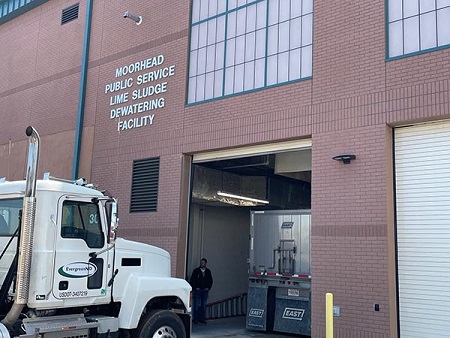
The new dewatering plant in Moorhead operates with a plate-and-frame filter press.

A new chapter in a lengthy history of providing water in the Red River Valley has come to Moorhead, Minnesota, the first city on the Red River of the North to draw surface water for treatment, beating out Fargo, North Dakota, by about 1,300 feet.
Nearly unnoticeable in tame times, the Red River has been a miles-wide lake in times of high water. Although stable for the most part, the Red River can be an unreliable source of drinking water. Moorhead Public Service (MPS) has expanded over the decades to include multiple surface water and groundwater sources to ensure reliable service to its customers and flexibility in its operations.
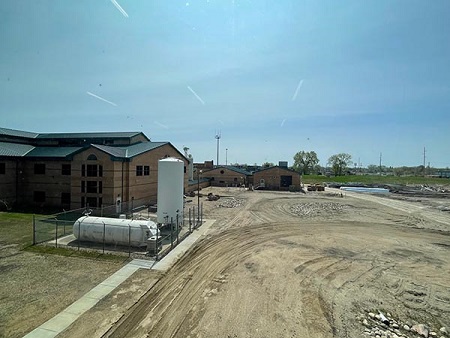
The existing plant is to the south of the new dewatering building.
Geology
Geologic history, physical properties, and land use define water characteristics of this area. The extreme western regions of northern Minnesota are topographically flat with soils that are heavy in clay that drain poorly. The topography and underlying drift are related to the last glacial period, which retreated from the state approximately 10,000 years ago. Minnesota’s most prominent glacial lake was Lake Agassiz, which was larger than all of today’s Great Lakes combined. Lake Agassiz occupied the northwest portion of Minnesota, providing settling points for silt and clay, which impede the movement of groundwater.
Long before this, salt-water bodies invaded the region and left a sheet of marine sediments, including sandstones, shales, and limestones. A period of erosion followed the withdrawal of the ancient seas, but during the Cretaceous period the area was occupied by another sea that left sediments tilted gently toward the west. Near the Red River, which serves as the boundary between North Dakota and Minnesota, the presence of the Cretaceous beds is still evident by the saltiness of the water derived from them and contributes to high total hardness and dissolved solids in area source waters.
Larry Cole, a former Minnesota Department of Health district engineer, explained why a water supply adjacent to the Red River is so challenging: “There are two factors involved: the shallow soils that are heavy in clay and fertile, making the Red River Valley the breadbasket of the world, but aren’t the sort of thing to develop a water supply in. And the deep soils have the old sea-bed water in them. The upper soils don’t yield water; the lower soils are salty.”
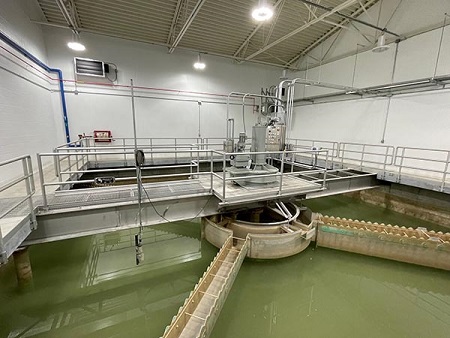
Water from the thickening basin (above) goes to the plates, which are compacted by a hydraulic ram (below).
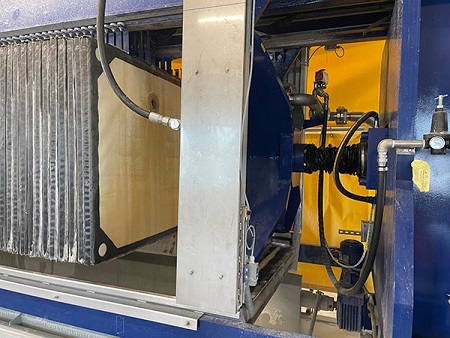
Moorhead Water History
Prior to 1900, Moorhead had once used untreated surface water to supply its citizens with water. At the turn of the last century, cholera and typhoid outbreaks associated with raw surface water prompted the city to switch to aquifers around 1905. Moorhead supplied 100% of its water needs via groundwater for the next 50 years.
In 1950, Moorhead built its first treatment plant, specifically designed to soften groundwater. The facility was centrally located between multiple wellfields that tapped into the Moorhead and Buffalo aquifers, about three miles east of the Red River. In 1959, the utility tripled its capacity with a plant expansion that added surface water back into its water supply portfolio, including a new Red River intake structure, pump station, and transmission pipeline.
Because of taste and odor problems associated with the river, Moorhead historically drew 60 percent of its annual flows from the Red River. Well water produced a blend, diffusing the river water and improving its aesthetic quality. In addition, the cool groundwater helped offset the river water temperatures, which could be 80 degrees in the summer.
In the 1980s MPS looked at further expansion to accommodate residential growth and increased industrial demand. Anticipation of more stringent standards for disinfection byproducts prompted a look at getting away from free chlorine, which had been added before and after filtration in previous treatment systems.
A transition to monochloramines would reduce the disinfection byproducts, but MPS envisioned more. Ozone as a primary disinfectant could not only keep down the trihalomethanes and haloacetic acids, it also controlled taste and odor problems, allowing the utility to increase its use of the river and leave the limited groundwater supplies as a secondary or backup source. Thus, when the “New Plant” went on-line in late 1994, Moorhead increased is capacity to 16 million gallons per day and became the first city in Minnesota to use ozone. (It remains the only city to do so, although others are now considering or implementing it.) By introducing ozone as its main disinfectant, MPS reduced its use of chlorine by more than 50%, thereby easily meeting the standards for disinfection byproducts, and it discontinued free chlorine altogether via the use of chloramines for post-disinfection.
Twenty-first Century Challenges
In 2015, the Minnesota Pollution Control Agency (MPCA) reclassified lime solids, a residual from the softening process, as industrial solid waste. MPS has 12 existing storage ponds for lime, all of which were approaching their storage capacity. At the time, MPS was in process of distributing requests for proposals for additional pond construction, but the reclassification prompted them to quickly look at other options.
“It was ‘go time’ from there,” said water plant manager Marc Pritchard, adding that the storage and disposal process would become much more expensive with the additional restrictions of the MPCA ruling.
Instead of opting for new ponds that would need to be dredged every third year, MPS decided to construct a dewatering facility to the north of its treatment facility. Construction began in early 2020, “just before the world changed,” according to Pritchard, referring to the global pandemic that made all aspects of life trickier. Working through a variety of COVID-related challenges, construction stayed on track and was completed in 2021. “You just have to adapt. And they did,” said John Thom of SEH, Inc. of Vadnais Heights, Minnesota, which designed the dewatering plant.
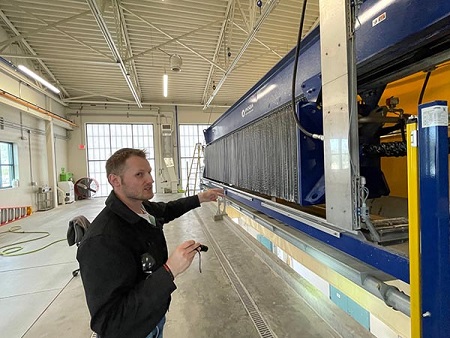
Marc Pritchard (above) explains the dewatering process. Ryan Knutson (below) oversees one of the press cycles.
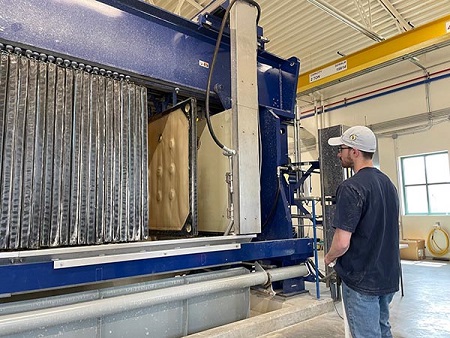
The new dewatering process uses a plate-and-frame filter press with a hydraulic ram to force the plates of the press together. Lime residuals from the softening basin in the main treatment facility are piped to the new building’s thickening basin on the upper level and then into each of the spaces between the plates in the new filter press. MPS lead operator Jason Yonke said the 116 plates end up with 8-1/3 cubic yards of dewatered lime per cycle. The plates are separated one at a time with the dewatered lime “cake” dropping through bomb-bay doors into the bed of a truck on the first level. The truck is full after three press cycles for a total of approximately 25 cubic yards.
At this point, a driver pulls up to the facility with an empty truck, pulls the full truck outside, brings the empty truck in, and drives the full truck away. The swap of trucks takes place twice a day with the dewatered lime solids taken more than 120 miles to central Minnesota and used for land application. Disposal is the biggest cost, although the operational costs are lower than the long-term requirements of repeated dredging of additional storage ponds.
Although the process is now achievable with just one filter press, the building was constructed with room for another press with an additional truck bay below.
Spanning three different centuries in supplying drinking water, Moorhead Public Service has stayed flexible, incorporating new technologies to meet demand and respond to changing conditions and regulations.
Did You Know?
The Moorhead Armory was to be the site of a concert in February 1959 that was canceled when the en-route musicians—Buddy Holly, Ritchie Valens, and the Big Bopper—were killed when their plane crashed after takeoff in Clear Lake, Iowa.
Go to > top.